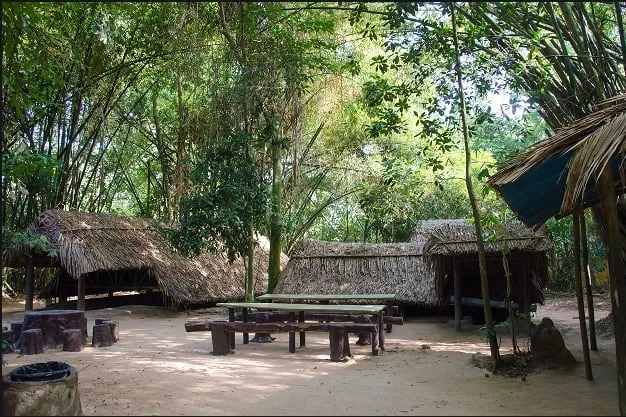Contents
ToggleWhere is Cat Cat Village?
Cat Cat Village is nestled in the breathtaking Hoàng Liên Sơn mountain range, just 3 kilometers (about 2 miles) from the center of Sapa town, in San Sa Hồ commune, Lào Cai Province, northern Vietnam. Surrounded by terraced rice fields, cascading waterfalls, and misty valleys, it is one of the most easily accessible ethnic minority villages in the Sapa region—making it a perfect destination for travelers who want to experience authentic hill tribe culture without venturing too far off the beaten path.
A short walk or motorbike ride from central Sapa brings you to this charming Hmong village, where traditional wooden houses, stone-paved lanes, and vibrant textile shops create a rustic yet inviting atmosphere. Set against a dramatic mountainous backdrop, Cat Cat’s location also makes it a fantastic base for scenic photography, cultural exploration, and gentle trekking.
While many villages in northern Vietnam require long treks to reach, Cat Cat’s close proximity means you can enjoy a rich cultural and natural experience within just a few hours. Whether you’re on a tight schedule or planning a deeper adventure through the highlands, Cat Cat Village offers a memorable glimpse into the daily life of Vietnam’s ethnic minorities—just minutes from the heart of Sapa.
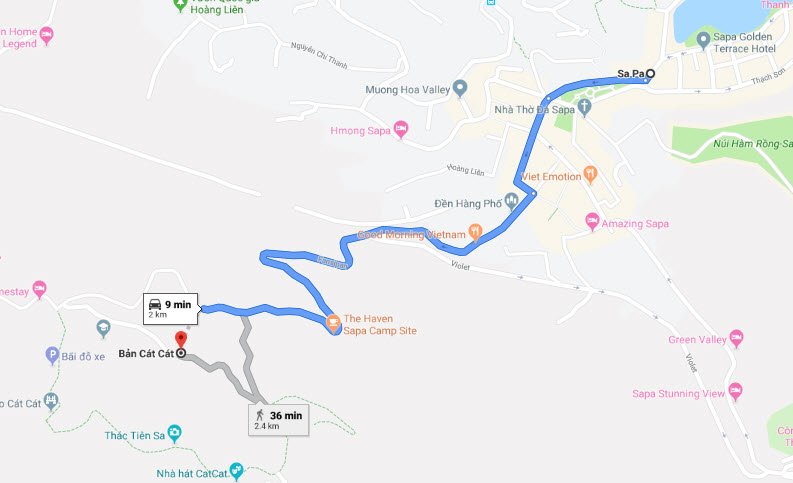
The Origin of the Name “Cat Cat”
At first glance, the name Cat Cat Village might lead visitors to believe it has something to do with felines—but in reality, the origin is far more interesting and rooted in colonial history and linguistic transformation.
The story dates back to the early 20th century during the period of French colonial rule in Vietnam. French explorers and colonialists, captivated by the dramatic beauty of a picturesque waterfall near the present-day village, began referring to the site using the word “cascade”—the French term for waterfall. However, as they often did when encountering unfamiliar local languages, they phonetically adapted the term to fit their pronunciation and context, and it became known as “Catscat.”
Over time, this foreign-sounding name was gradually absorbed into the Vietnamese language and further simplified by local communities to “Cát Cát.” As the area around the waterfall grew in popularity and significance, the name Cát Cát became synonymous with the entire village, and that name remains today.
So, while Cat Cat Village may sound like it’s named after a cuddly animal, its name actually reflects a unique intersection of French colonial influence, natural beauty, and local oral tradition. It’s a small but fascinating example of how language and history shape place names across cultures—and it adds another layer of charm to one of Sapa’s most visited and culturally rich destinations.
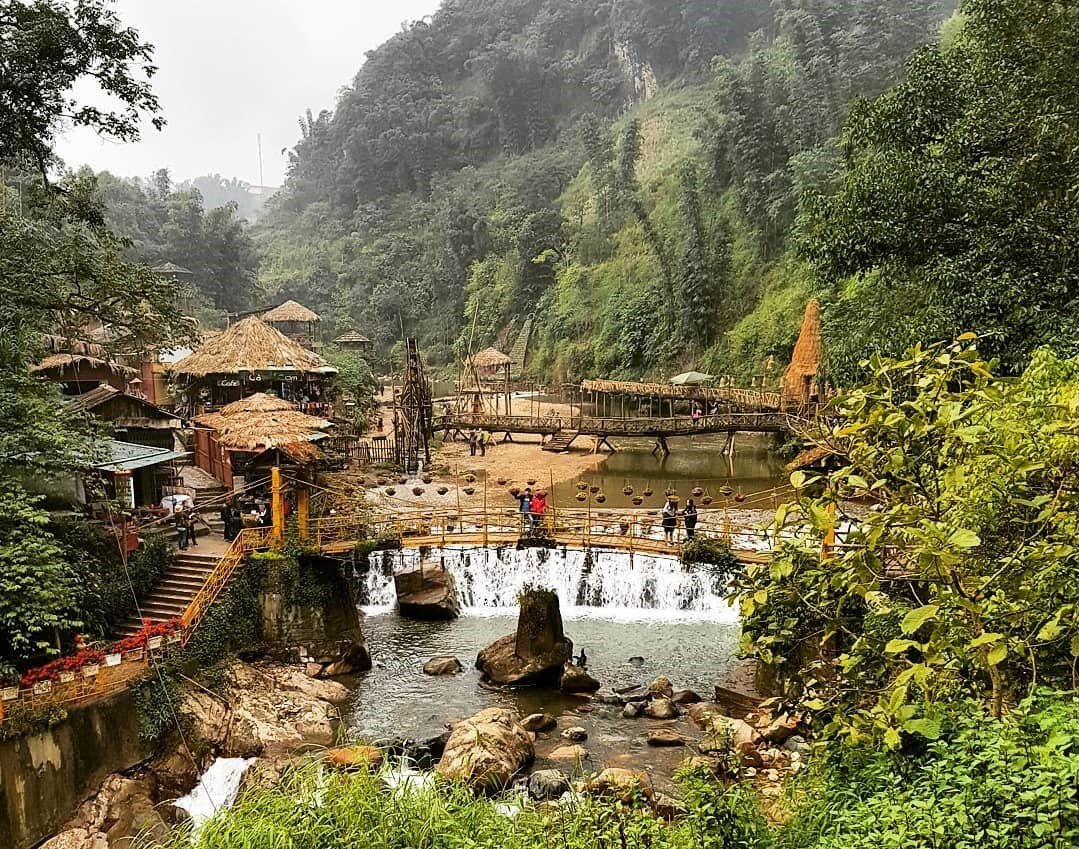
How to Get to Cat Cat Village
Cat Cat Village is one of the most accessible ethnic villages in the Sapa region, making it a perfect half-day trip for travelers staying in or near Sapa town. Here’s how to reach this charming destination:
🛣️ From Hanoi to Sapa
To begin your journey, you’ll first need to get from Hanoi to Sapa, a distance of about 320 kilometers (200 miles). Fortunately, there are several convenient and comfortable transportation options available:
- By Bus or Limousine Van: Modern sleeper buses and luxury vans depart frequently from Hanoi and reach Sapa in approximately 5.5 to 6 hours. Limousine vans, though slightly more expensive, offer reclining seats, Wi-Fi, and fewer passengers—ideal for those seeking comfort.
- By Overnight Train: For a more traditional and romantic experience, you can take an overnight train from Hanoi to Lao Cai, followed by a one-hour drive up the mountain to Sapa. While it takes a bit longer, many travelers enjoy the gentle rhythm of the train and the scenic ride through northern Vietnam.
🥾 From Sapa Town to Cat Cat Village
Once you’re in Sapa town, reaching Cat Cat Village is easy and offers a chance to enjoy the region’s breathtaking landscapes. There are two main ways to get there:
- On Foot: Walking from Sapa to Cat Cat takes about 45 minutes. The route is downhill and fully paved, offering sweeping views of the Hoang Lien Son mountain range, misty rice terraces, and small roadside shops along the way. Many visitors enjoy this scenic walk as part of the overall experience.
- By Motorbike or Taxi: If you’re short on time or prefer a quicker trip, you can hop on a motorbike taxi or hire a regular taxi. The ride takes just 10 minutes and drops you off near the village entrance. Motorbikes are especially convenient for those who wish to return uphill without the effort of a climb.
Travel Tip: While the road is paved and in good condition, it can be steep in places. A popular option is to walk downhill to the village and then take a taxi or motorbike back up to Sapa—saving both time and energy on the return trip.

Is Cat Cat Village Worth Visiting?
Cat Cat Village is often the first stop for travelers arriving in Sapa, and for good reason. Just a short walk from the town center, this picturesque H’Mong village offers a convenient and visually rich introduction to northern Vietnam’s highland culture and landscapes.
If you’re short on time or traveling with family, Cat Cat delivers a little bit of everything in one compact, walkable area: terraced rice fields, rustic wooden homes, small waterfalls, bamboo bridges, and scenic mountain backdrops. The sound of flowing streams, the sight of women weaving hemp cloth by hand, and the gentle scent of burning wood from traditional stilt houses all create a pleasant, immersive atmosphere.
However, it’s important to set the right expectations. Cat Cat is highly developed for tourism, and much of the experience feels curated for visitors. You’ll find:
- Souvenir shops selling hand-embroidered textiles, silver jewelry, and herbal remedies
- Photo opportunities with rented ethnic costumes, ideal for Instagram moments
- Staged cultural performances featuring traditional dances and music during peak hours
- Clearly marked walking paths and rest stops
While these touches can enhance your visit, they also make Cat Cat feel more like a cultural showcase than a living village. It’s not uncommon to see a blend of authenticity and commercialization side by side.
That said, Cat Cat Village still holds value—especially for first-time visitors to Sapa or those with limited time. The views are undeniably beautiful, the infrastructure is visitor-friendly, and it offers easy access to the area’s natural charm.
Travel Tip: For a more authentic, less-touristy experience, consider combining your visit to Cat Cat with a day trek or overnight homestay in villages like Ta Van, Lao Chai, or Y Linh Ho. These more remote communities provide deeper cultural interaction and a quieter, more traditional feel.
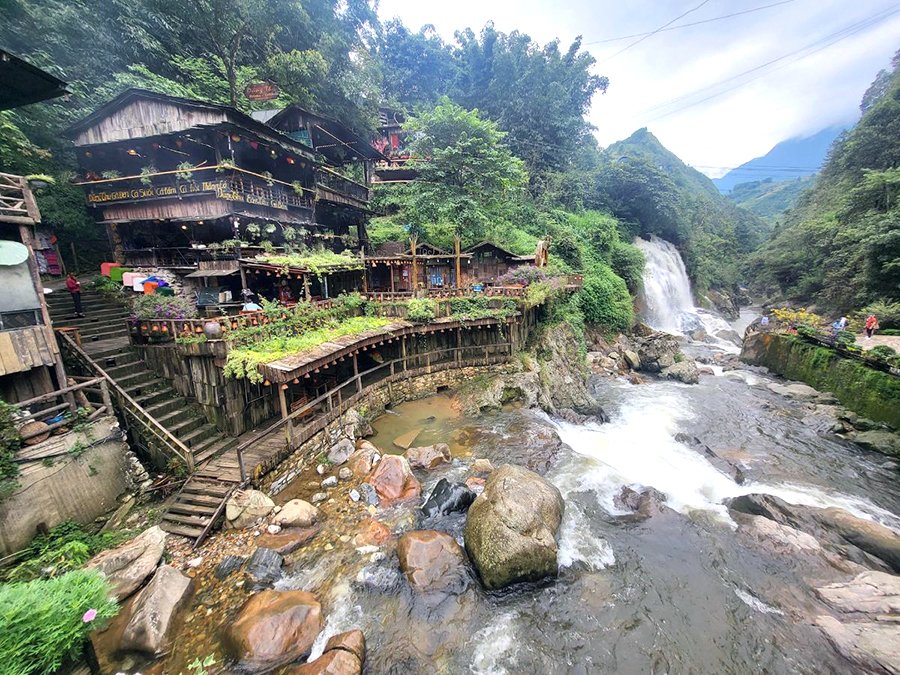
Top Things to Do in Cat Cat Village
Despite its compact size, Cat Cat Village offers a variety of engaging experiences that showcase the natural beauty, artisan traditions, and cultural heritage of the H’Mong people. Whether you’re a casual traveler or a photography enthusiast, here are the top things to see and do:
1. Marvel at Cat Cat Waterfall (Also Known as Tien Sa Falls)
At the heart of the village lies Cat Cat Waterfall, a picturesque cascade framed by wooden bridges, stone walkways, and traditional bamboo water wheels. The peaceful sound of falling water blends perfectly with the surrounding mountain scenery. Don’t miss nearby photo spots like the Si Bridge and A Lu Bridge, which offer stunning vantage points over the falls and riverbanks. It’s an ideal stop for nature lovers and Instagrammers alike.
2. Step Inside Traditional H’Mong Homes
The architecture of Cat Cat Village is as fascinating as its landscape. H’Mong houses are built with wood, stone, and clay, and usually follow a three-part structure: a central living area with a hearth, an altar for ancestor worship, and a loft for drying food or storing goods. Walking through these homes—or even staying overnight in a local homestay—gives insight into the rhythm of rural life. Cooking meals over an open fire, listening to folk stories, or watching the stars from a wooden balcony offers a connection that goes beyond sightseeing.
3. Visit Local Artisan Workshops
One of Cat Cat’s most meaningful experiences is observing (or joining) the age-old crafts still practiced by H’Mong women. Look for small workshops where locals:
- Weave hemp cloth by hand
- Use batik wax techniques and natural indigo dyes
- Embroider traditional motifs representing family or tribal identity
You can purchase authentic handicrafts here, but be discerning—avoid stalls selling mass-produced souvenirs that don’t benefit the community.
➡️ Insider Tip: Ask if you can join a weaving or dyeing workshop. It’s a hands-on experience that not only supports local women but also deepens your appreciation of H’Mong artistry.
4. Walk Among Terraced Rice Fields
Cat Cat’s surrounding rice terraces are a visual feast and change dramatically with the seasons:
- April–May: Flooded terraces glimmer like mirrors under the sun
- June–August: The fields turn a vibrant green as rice begins to grow
- September–October: The golden harvest blankets the hills in warm hues
Walking among the terraces is more than scenic—it’s a window into Vietnam’s agricultural soul. You’ll see farmers working with buffaloes, kids playing in the paddies, and quiet trails that make you feel like you’re walking through a living painting.
5. Watch the Cat Cat Cultural Show
Held in a modest open-air amphitheater, the Cat Cat Cultural Show brings H’Mong folklore to life with seven short performances. The acts blend traditional dances, music, and symbolic reenactments of village life, from marriage customs to harvest celebrations. Accompanied by traditional instruments like the khen (reed pipe) and sáo trúc (bamboo flute), the show is colorful, melodic, and family-friendly—even if a little staged.

Cat Cat Village Entrance Fees (2025 Rates)
To enter Cat Cat Village, all visitors are required to purchase a ticket at the main gate. The entrance fee includes access to the entire village area, including waterfalls, cultural zones, and performance spaces.
- Adults: 150,000 VND (approximately €5.50 / $6.50)
- Children (height between 1 meter and 1.4 meters): 70,000 VND (approximately €2.60 / $3.00)
- Children under 1 meter in height: Free admission
Traditional Costume Rental (Optional):
Just outside the entrance, you’ll find several rental stalls offering H’Mong-style traditional outfits for photo opportunities. Prices typically range from 100,000 to 150,000 VND (€3.70 to €5.50) depending on the quality and style of the costume. It can be a fun way to enhance your visit and take memorable photos—but remember to wear the outfits respectfully, as they hold deep cultural meaning for the local people.
So, Who is Cat Cat Village For?
Cat Cat Village is ideal for travelers who want a quick and easy introduction to the ethnic culture and natural beauty of the Sapa region. It’s designed to be accessible and visually impressive, making it perfect for:
✅ First-time travelers to Sapa – It offers a compact and curated glimpse into local H’Mong traditions, perfect for those just beginning to explore the region.
✅ Families with children – The walkable layout, engaging sights, and cultural performances make it family-friendly and easy to navigate with kids.
✅ Travelers short on time – If you only have half a day in Sapa, Cat Cat is the most convenient option to see rice terraces, waterfalls, and local crafts.
✅ Photography lovers – The village is full of postcard-perfect scenes, from terraced fields and bamboo bridges to traditional houses and costumed locals.
However, it might not be the best fit for:
❌ Travelers seeking off-the-grid, non-touristy experiences – Cat Cat is quite developed for tourism, with souvenir stalls, staged performances, and crowds during peak season. For a more authentic experience, consider hiking to remote villages like Ta Van, Lao Chai, or Y Linh Ho, where tourism blends more naturally with daily life.
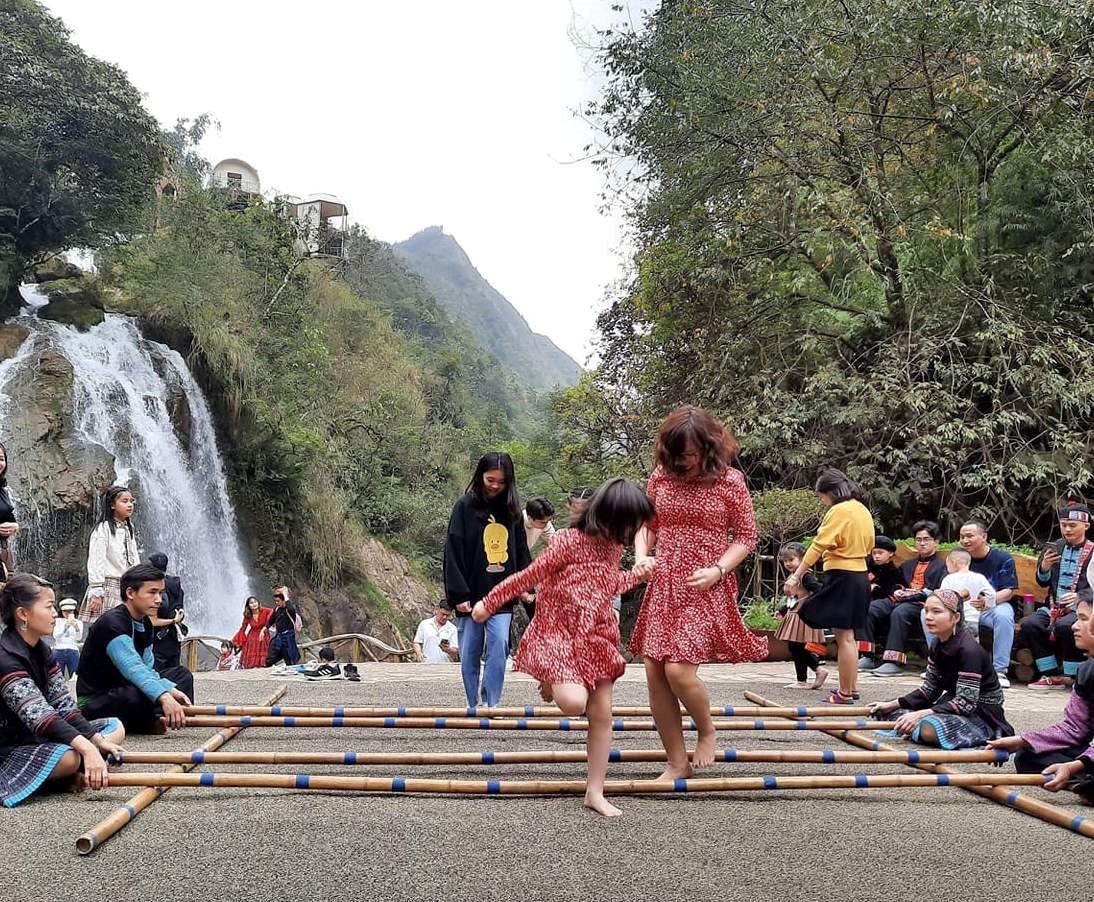
Final Thoughts: Is Cat Cat a Must-See in Sapa?
Yes—with the right mindset.
Cat Cat isn’t untouched by tourism, but it’s not void of meaning either. It offers a gateway to H’Mong traditions, and a scenic, educational half-day trip that’s especially helpful for first-time visitors.
If you have more time, go deeper—visit Lao Chai, Ta Van, or Sin Chai for rawer, more immersive village life. But don’t write off Cat Cat entirely—it may just surprise you with its beauty, resilience, and layers of story beneath the surface.













